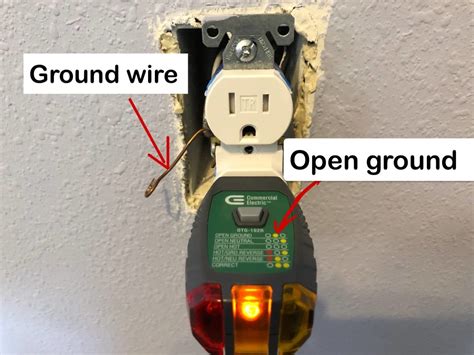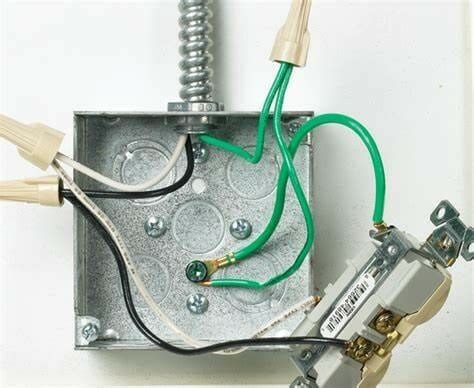electrical box grounding In a word: Safety. If the current powering our lights, appliances and tools could kill us, it’s important to mitigate that danger, right? Grounding is how we accomplish that, and there are two ways we do it: See more Virtually all of our replacement Bus panels and bumpers are sourced from Europe or from Volkswagen/Brazil and are the finest available. Quality replacements fit better to begin with, and last longer without rusting. Compare both our prices and our quality - you will not be disappointed.
0 · what is a ground outlet
1 · pigtail ground to metal box
2 · how to ground electrical outlet
3 · grounding screws for metal boxes
4 · grounding requirements for residential homes
5 · grounding outlet to metal box
6 · grounding outlet into metal box
7 · electrical grounding for dummies
Junction box enclosure designed for use with WAGO 221-4, 2273 and 2773 series connectors (connectors not included) The WAGOBOX 221-4 is rated 400V/4KV and can support conductor sizes from 0.14mm2 to 4mm2; Quick and easy to install; .
Whether you’re an experienced DIYer or just getting started, electrical grounding is one of the most important — and confusing — concepts to grasp. Maybe you’ve heard of grounding, but aren’t sure exactly what it does. Maybe you’ve seen, and even connected, the green “ground wire” in a DIY electrical . See moreGrounding means connecting to the Earth, or extending the ground connection to other things in your home — even if they’re far away from the actual ground. Establishing a connection to the Earth has several safety and logistical benefits, and it’s been required in . See more
When you walk into a room and flip on a light switch, electricity in the form of current flows through the switch to the light. This electrical current is made up of electrons, tiny subatomic particles that are constantly on the move. It’s these electrons that cause . See moreSo we know grounding is important, but how does it work? Why does connecting to ground make things safer? This can be confusing, but stay with me. When you were a child, did you ever walk across carpet in your socks, then touch your friend to give them a . See more
In a word: Safety. If the current powering our lights, appliances and tools could kill us, it’s important to mitigate that danger, right? Grounding is how we accomplish that, and there are two ways we do it: See more Grounding offers excess electricity the most effective and safest route from an appliance back to the ground by way of an electrical panel. Electrical grounding is a backup pathway that is generally only used if there is .
Read about different ways of grounding switches and outlets in metal and plastic electrical boxes. From a safety perspective, an electrical enclosure should be positively and correctly grounded so as to rid any electrical faults. Resistance of the ground path from the electrical enclosure box back to source ground .
While grounding and bonding might seem like the same thing, they have some very important differences. Electrical bonding is the practice of connecting metallic objects that may be exposed to electrical faults or induced voltages to the .
Section 90.2(A) of the National Electrical Code, “Practical Safeguarding,” contains the Code’s purpose, which is to provide the practical safeguarding of people and property from .It’s required by the NEC(National Electrical Code) to have junction boxes grounded, especially for metal ones. Grounding will always be a staple in every home’s electrical circuit because of the safety benefits. Note that non-metal . Most of your home's receptacles should be grounded. If they're not, learn four different ways to add this safety feature. If you have an older home, you'll need to make sure that your electrical outlets are grounded.A metal electrical box must have a separate grounding pigtail connected to it, then connected to all the ground wires in that box. Looping the feed wire ground around the grounding screw and using the end for a pigtail connection has .
Your house wiring is an electrical system, connected to ground at your electrical panel. Tools, appliances, lights and electronics need specific voltages to operate correctly and safely, and system grounding stabilizes these voltages.

metal ratchet socket storage box
what is a ground outlet

Grounding offers excess electricity the most effective and safest route from an appliance back to the ground by way of an electrical panel. Electrical grounding is a backup pathway that is generally only used if there is a fault in the wiring system. Read about different ways of grounding switches and outlets in metal and plastic electrical boxes.
From a safety perspective, an electrical enclosure should be positively and correctly grounded so as to rid any electrical faults. Resistance of the ground path from the electrical enclosure box back to source ground should be very low. This "earth ground" is a very important part of your electrical system to ensure electrical safety. According to the National Electrical Code, or NEC, a ground system should have a grounding resistance of 25 ohms or less. Achieving this may require more than one ground rod.While grounding and bonding might seem like the same thing, they have some very important differences. Electrical bonding is the practice of connecting metallic objects that may be exposed to electrical faults or induced voltages to the grounding conductor.
Section 90.2(A) of the National Electrical Code, “Practical Safeguarding,” contains the Code’s purpose, which is to provide the practical safeguarding of people and property from hazards associated with the use of electricity. Chapter 2, “Wiring and Protection,” is where the general grounding and bonding requirements are located, specifically in Article 250.
It’s required by the NEC(National Electrical Code) to have junction boxes grounded, especially for metal ones. Grounding will always be a staple in every home’s electrical circuit because of the safety benefits. Note that non-metal junction boxes DO NOT need to be directly grounded. Most of your home's receptacles should be grounded. If they're not, learn four different ways to add this safety feature. If you have an older home, you'll need to make sure that your electrical outlets are grounded.A metal electrical box must have a separate grounding pigtail connected to it, then connected to all the ground wires in that box. Looping the feed wire ground around the grounding screw and using the end for a pigtail connection has been disallowed, beginning with the 2020 National Electrical Code (NFPA 70) article 250.148(C).
Your house wiring is an electrical system, connected to ground at your electrical panel. Tools, appliances, lights and electronics need specific voltages to operate correctly and safely, and system grounding stabilizes these voltages. Grounding offers excess electricity the most effective and safest route from an appliance back to the ground by way of an electrical panel. Electrical grounding is a backup pathway that is generally only used if there is a fault in the wiring system.
Read about different ways of grounding switches and outlets in metal and plastic electrical boxes.
From a safety perspective, an electrical enclosure should be positively and correctly grounded so as to rid any electrical faults. Resistance of the ground path from the electrical enclosure box back to source ground should be very low. This "earth ground" is a very important part of your electrical system to ensure electrical safety. According to the National Electrical Code, or NEC, a ground system should have a grounding resistance of 25 ohms or less. Achieving this may require more than one ground rod.
pigtail ground to metal box
While grounding and bonding might seem like the same thing, they have some very important differences. Electrical bonding is the practice of connecting metallic objects that may be exposed to electrical faults or induced voltages to the grounding conductor. Section 90.2(A) of the National Electrical Code, “Practical Safeguarding,” contains the Code’s purpose, which is to provide the practical safeguarding of people and property from hazards associated with the use of electricity. Chapter 2, “Wiring and Protection,” is where the general grounding and bonding requirements are located, specifically in Article 250.It’s required by the NEC(National Electrical Code) to have junction boxes grounded, especially for metal ones. Grounding will always be a staple in every home’s electrical circuit because of the safety benefits. Note that non-metal junction boxes DO NOT need to be directly grounded.
Most of your home's receptacles should be grounded. If they're not, learn four different ways to add this safety feature. If you have an older home, you'll need to make sure that your electrical outlets are grounded.
metal railing flower box holder

Amera-Seiki offers a complete line of CNC Lathe Turning Centers and Vertical .
electrical box grounding|grounding outlet into metal box